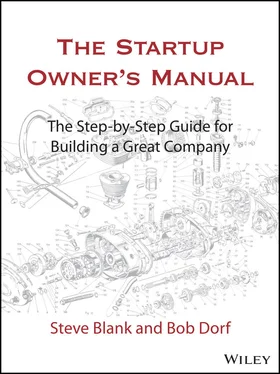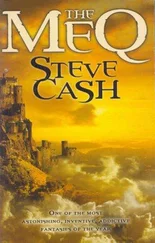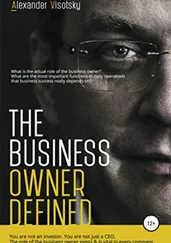While searching : Customer Development observes that at the start, the company and its business model are based solely on hypotheses, not facts, and that the founders need to get out of the building to turn these hypotheses into customer data. This “get out of the building” approach, combined with rapid iteration and pivots, is central to the model’s customer discovery and validation steps.
…preserve cash while searching for the repeatable and scalable business model.
Repeatable : Startups may get orders that stem from board members’ customer relationships, engineering one-offs, or heroic single-shot efforts by the CEO. These are great, but they aren’t repeatable by a sales organization. Search not for the one-off revenue hits but rather for a pattern that can be replicated by a sales organization selling off a price list or by customers regularly visiting the website.
Scalable : The goal is not to get one customer but many—and for each additional customer to add incremental revenue and profit. The test is: Does the addition of one more salesperson or more marketing dollars bring in more gross profit (or users or clicks) than you invested? Who influences a sale? Who recommends a sale?
Who is the decision-maker? Who is the economic buyer? Where’s the budget for purchasing this type of product? What’s the customer acquisition cost? Affirming the repeatable, scalable sales model is the customer validation step of Customer Development, its most important phase. Has the team learned how to sell a target customer? Can this happen before the startup runs out of money?
Search not for the one-off revenue hits but rather for a pattern…
Business model : A business model answers the basic questions of how the company makes money. Is this a revenue play, or is it a freemium model seeking users? Something else? Who’s the customer?
Spend like there’s no tomorrow : The goal of an investor-backed startup is not to build a lifestyle business. The goal is to reach venture scale (10 times the return on investment or more). When management and board agree that they’ve found a repeatable and scalable sales model (i.e., have a product/market fit), then invest the dollars to create end-user demand and drive those customers into the sales channel .
Rule No. 13:
Communicate and Share Learning
An integral part of Customer Development’s “learning and discovery” philosophy is sharing everything that’s learned outside the building with employees, co-founders and even investors.
The traditional way to do this is via weekly company meetings to keep employees informed and board meetings to let the investors understand the progress made in the search for the business model. But technology in the 21st-century has taken us to places we never could get to before. We can now communicate all we’re learning in near-real time to everyone who needs to know.
We strongly recommend that the founders keep and share all their activities in the customer discovery step covered in Chapter 3 via a blog, CRM or product management tool. A powerful tool to help founding team members and their investors and advisors communicate about progress in evolving their business model and sharing or discussing customer discovery has been developed in concert with the authors and can be found at LaunchPadCentral.com. Think of it as a narrative of the customer discovery process. It records hypotheses the startup started with, who the team has talked to, the questions asked, the tests conducted, what’s been learned, and questions for advisors or investors. While this may seem burdensome, it takes less time than having a weekly coffee with an advisory board member. What results is a communications tool allowing outsiders to view the company’s progress up close and to offer suggestions and course corrections.
Rule No. 14:
Customer Development Success Begins With Buy-In
Customer Development’s “learning and discovery” philosophy can be immensely disorienting to a founder, engineer or investor who has spent his or her career executing a plan . For Customer Development to succeed, everyone on the team—from investor or parent company to engineers, marketeers and founders—needs to understand and agree that the Customer Development process is different to its core. If the engineering VP is talking waterfall development or the board demands a rigid timetable, Customer Development is destined for disaster. Everyone must accept the process, recognizing that this is a fluid, nonlinear search for a business model that can sometimes last for years.
The Customer Development process is different to its core.
Customer Development changes almost every aspect of startup behavior, performance, metrics, and, as often as not, success potential. It’s not just a “nice to do” while executing the revenue model in the back of the business plan. Customer Development reinvents the business model on the fly , iterating often and pivoting whenever indicated. Founders need to have the commitment of the team and board before embarking on Customer Development. Ensure that all understand and agree that it’s iterative, necessary, and worthwhile and that it changes the benchmarks and metrics along the way.
Comments such as “The product is already spec’ed, and we can’t change the features since development is already underway,” or “We already have the factory (or sales team or marketing materials) built,” or “We have to launch to make the numbers in the plan,” are all red flags. To succeed at Customer Development, the company must abandon the old model’s emphasis on execution of a fantasy business plan. Instead it must commit to a Customer Development process stressing learning, discovery, failure, and iteration in the search for a successful business model. If you’re ready for this process, this book will tell you how to do it.
Summary: The Customer Development Process
The Customer Development process reflects the best practices of winning startups. It is the only approach for web-based businesses where failure is certain without constant customer feedback and product iteration as they search for their audiences. Customer Development’s fast cycle times and inherent cash conservation gives all entrepreneurs more chances to pivot, iterate, and succeed before the bank account runs dry. Describe this model to entrepreneurs who have taken companies all the way to a lucrative exit and beyond, and heads nod in recognition.
While each step has its own specific objectives, the process as a whole has one overarching goal: discovering the repeatable, scalable, and ultimately profitable business before running out of cash. This transforms the company from a set of founding hypotheses into a moneymaking endeavor.
Customer Development is damn hard work. You can’t fake it.
Customer Development is damn hard work. You can’t fake it. You can’t just do the slides or “do” the process in a weekend. It’s a full-time, full-body-contact sport. It’s a long-term commitment to changing the way a startup is built. But it’s also proven to increase the chances of startup success.
II Step One: Customer Discovery
Chapter 3:
An Introduction to Customer Discovery
Chapter 4:
Customer Discovery, Phase One:
State Your Business Model Hypotheses
Chapter 5:
Customer Discovery, Phase Two:
“Get Out of the Building” to Test the Problem: “Do People Care?”
Chapter 6:
Customer Discovery, Phase Three:
“Get Out of the Building” and Test the Product Solution
Читать дальше











